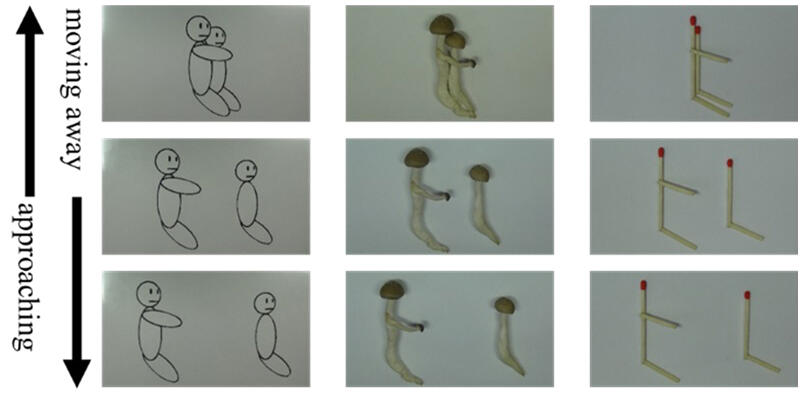When shimeji mushrooms were arranged in pairs to look like a parent and child sleeping together, they looked more human and emotional than matchsticks arranged in the same way, but not as much as simple humanoid figures. However, when the three types of figures were made to move, the mushroom figures were perceived as having more emotion. The team conducting the research found that observers can feel as if a non-human object has emotions if the object has a moderately human-like shape. (This is called "emotional state attribution.") They found that when social motion is added to such objects, strong emotional state attribution is observed. However, there is little change in emotional state attribution for objects that are more human-like in shape. The team was led by Professor Kazuhiro Ueda of the Graduate School of Arts and Sciences at the University of Tokyo. It also included Graduate Student Taku Imaizumi of the Graduate School of Interdisciplinary Information Studies at the University of Tokyo, and Professor Kohske Takahashi of the College of Comprehensive Psychology at Ritsumeikan University. The results were published in Computers in Human Behavior.

Provided by the University of Tokyo
In the field of animacy perception, the movement of an object has been considered to cause emotional state attribution. Meanwhile, in the field of human-agent interaction, active research is being conducted using agents with human-like shapes. These agents are used so as to trigger emotional state attribution. Object shape and movement have been studied separately as factors affecting this. Although some existing research argued that adding movement to an object with a human-like shape may alter the emotional state attribution produced, no experimental studies had been conducted.
In the current study, participants were given a questionnaire on objects in still and moving images. They were asked whether the objects "had a human-like shape," and whether they "had emotions." In response to the question "Does it have a human-like shape?" humanoid figures, shimeji mushrooms and matchsticks were evaluated as human-like, in that order. When participants were shown still images, they rated the humanoid figures as having more "emotion" than the mushrooms. However, the situation was reversed when they saw video images of the objects approaching. After watching the video, participants rated mushrooms as having more "emotion" than the humanoid figures. In other words, when social motion was added, the mushrooms appear to have triggered strong emotional state attribution.
This finding suggests that viewers may have stronger emotional state attribution for an object that is not very human-like in shape if it exhibits social motion. Additionally, the team examined the effects of three-dimensionality on emotional state attribution for still and moving images. They also looked at how the presence or absence of facial features affects emotional state attribution. They found that three-dimensionality does not affect emotional state attribution. However, when motion is added, emotional state attribution is stronger for objects with no facial features.
The team integrated research findings on shape and movement, which had been studied separately. They showed that the effects of social motion on emotional state attribution may vary depending on how human-shaped the object is. In particular, they found that when motion was added, strong emotional state attribution was observed for objects whose shape was not very human-like. This explains the emotional state attribution that we see in everyday life.
A well-known case in Japan is the "shimeji mushrooms sleeping together" images. These went viral on X (formerly Twitter). Similarly, this research may provide a basis for considering the meaning of minimal design, i.e., the design of simple, less ornate characters. Furthermore, it can be used as an experimental underpinning for the design of emotionally rich agents. This should help create agents that users can easily empathize with.
Journal Information
Publication: Computers in Human Behavior
Title: Influence of appearance and motion interaction on emotional state attribution to objects: The example of hugging shimeji mushrooms
DOI: 10.1016/j.chb.2024.108383
This article has been translated by JST with permission from The Science News Ltd. (https://sci-news.co.jp/). Unauthorized reproduction of the article and photographs is prohibited.




